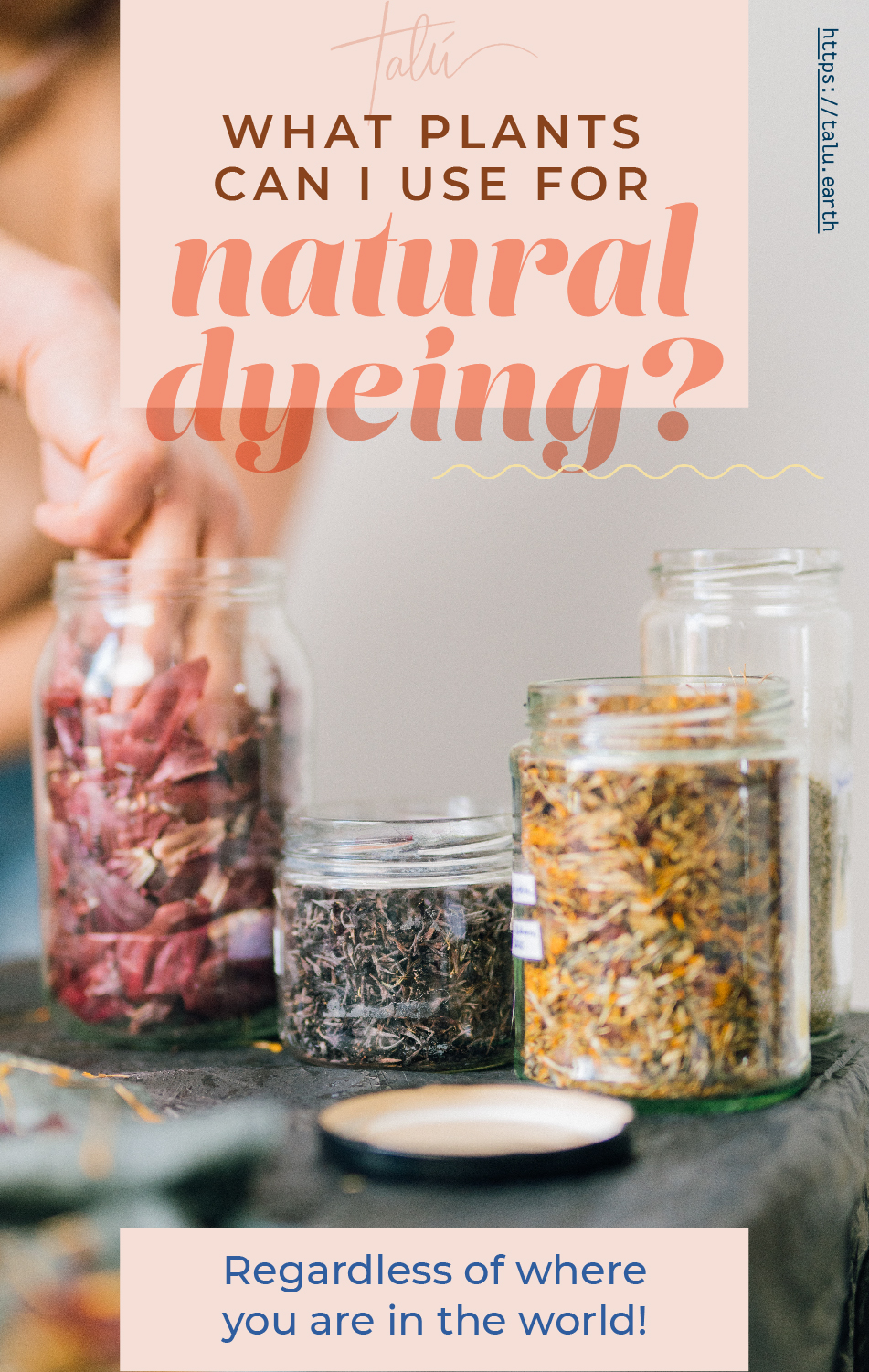When people first hear about natural dyeing for textiles, one of the first questions that come up is, “so, what plants can I use for natural dyeing?”. Well, the short answer is “loads!” No matter where you are in the world (except for Antarctica, probably), I can assure you there is a wide variety of plants waiting to be experimented with in dye pot: either in your kitchen, your garden or out in the wild. Here is a list of my recommendations. I also encourage you to explore the dyeing history in your region to discover your own local colour palette!
| Common name(s) | Scientific name | Part used |
|---|---|---|
| Alder (al varieties) | Alnus spp. | branches, leaves, bark, cones |
| Alder buckthorn | Rhamnus frangula | bark |
| Alkanet | Alkanna tinctoria | root |
| Avocado | Persea americana | skins and stones |
| Black tea | Camellia sinensis | leaves |
| Bracken fern (all varieties) | Pteridium spp. | leaves |
| Brazilwood | Haematoxylum brasiletto | wood |
| Buckthorn / Persian berries / Avignon berries | Rhamnus saxatilis | berries |
| Bushweeds / Flueggea tinctoria | Flueggea tinctoria | fruit |
| Butterfly bush / Buddleia (all varieties) | Buddleja spp. | flowers |
| Cannabis | Cannabis spp. | leaves |
| Carrot | Daucus carota | leaves |
| Dahlia (all varieties) | Dahlia spp. | flower |
| Dock (all varieties) | Rumex spp. | seeds, leaves and roots |
| Dyer's chamomile | Cota tinctoria | flowers |
| Dyer's coreopsis | Coreopsis tinctoria | flowers |
| Dyer's greenweed / Dyers Broom / Woadwaxen | Genista tinctoria | leaves and young shoots |
| Dyer's woodruff | Asperula tinctoria | roots |
| Eucalyptus (all varieties) | Eucalyptus spp. | leaves, bark |
| Goldenrod (all varieties) | Solidago spp. | fresh leaves |
| Hawthorn / Huath / Sceach gheal / Whitethorn | Crataegus monogyna | bark, branches, leaves |
| Heather | Calluna vulgaris | whole plant |
| Henna | Lawsonia inermis | leaves |
| Horse chestnut | Aesculus hippocastanum | leaves, bark |
| Ladys' bedstraw | Galium verum | roots |
| Laurel / Bay | Laurus nobilis | leaves |
| Logwood | Haematoxylum campechianum | wood |
| Madder | Rubia tinctorum | roots |
| Mahonia (all varieties) | Mahonia spp. | roots |
| Marigolds / Tagetes (all varieties) | Tagetes spp. | flower |
| Palo azul / Kidneywood | Eysenhardtia polystachya | wood |
| Mexican olive / White cordia / Texas wild olive | Cordia boissieri | leaves, branches |
| Mule fat / Seepwillow / Water-wally | Baccharis salicifolia | leaves |
| Mullein | Verbascum thapsus | leaves and flowers |
| Oak (all the varieties) | Quercus spp. | leaves, branches, bark |
| Old fustic / Dyer's Mulberry | Maclura tinctoria | wood |
| Osage orange | Maclura pomifera | wood |
| Palo santo / Verawood | Bulnesia sarmientoi | wood |
| Plume poppy / Tree poppy / Tree celandine / Parrotweed | Bocconia frutescens | bark |
| Polylepis / Queñua (all varieties) | Polylepis spp. | bark |
| Pomegranate | Punica granatum | peels (when they're fresh they give a better colour, when they're dry they're good for pre-treating cellulose fibres) |
| Red quebracho | Schinopsis lorentzii | wood |
| Red sandalwood | Pterocarpus santalinus | wood |
| Rhubarb | Rheum rhabarbarum | roots |
| Rudbeckia (all varieties) | Rudbeckia spp. | flowers |
| Safflower / Saffron | Carthamus tinctorius | petals |
| Sage | Salvia officinalis | leaves |
| Saw-wort | Serratula tinctoria | all except the roots |
| St. John’s Wort | Hypericum perforatum | flowers and leaves |
| Sulphur cosmos | Cosmos sulphureus | flowers |
| Tansy | Tanacetum vulgare | flowers |
| Walnut (all varieties) | Juglans spp. | husks |
| Weld | Reseda luteola | flowers and leaves |
| Wild madder | Rubia peregrina | roots |
| Willow (all varieties) | Salix spp. | leaves, bark, branches |
| Yarrow | Achillea millefolium | all the plant |
| Yellow and red onion | Allium cepa | skins |
| Yerba mate | Ilex paraguariensis | leaves |
| Zacatlaxcalli | Cuscuta tinctoria | whole plant |
What comes next?
Now that you’ve probably found a few plants around you that can help you give colour to your clothes, what comes next? There’s a lot of information out there about natural dyeing for textiles, but it can be misleading, confusing and overwhelming, especially when you think about the other question that people usually ask me: “how do you get the colour to stay?”. Fortunately, I have an online workshop tailored specifically towards getting you from absolutely no knowledge to confidently coaxing colour from plants and kitchen scraps like a true alchemist – from the comfort of your own home and at your own pace! Sounds enticing? Check out what it’s all about!
Pin this post!
